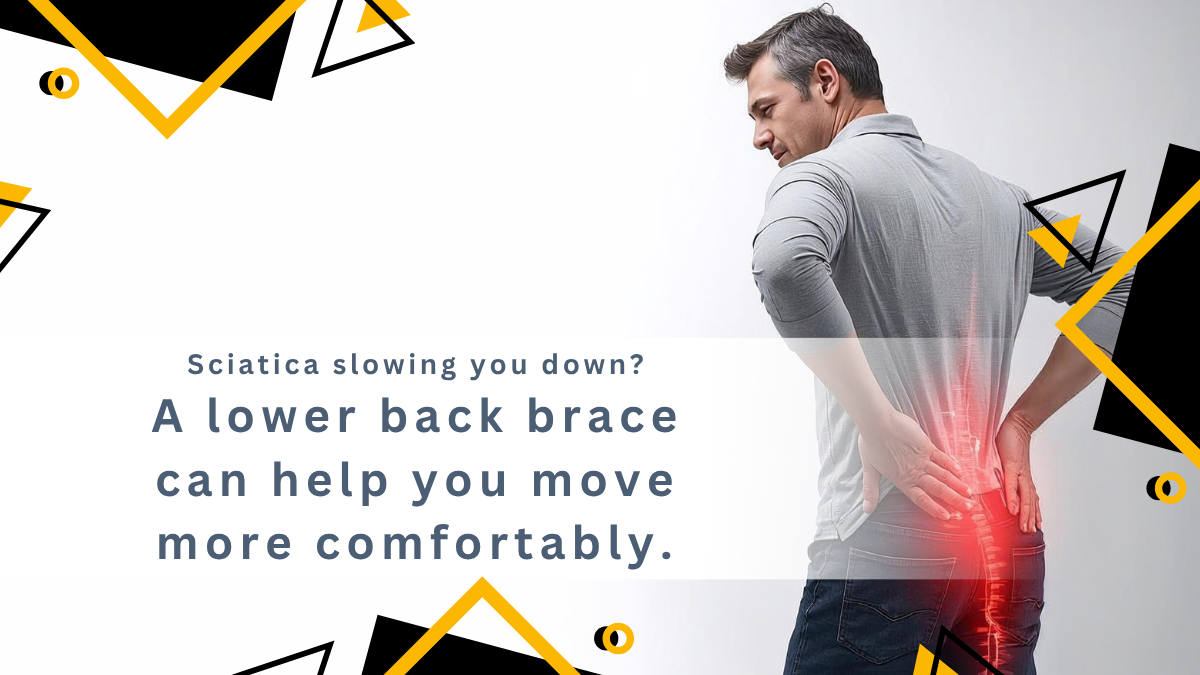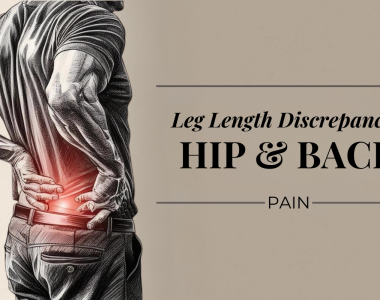No products in the cart.

Sciatica acting up? A practical guide to using a lower back brace to ease discomfort
If shooting leg pain is making sitting, walking, or sleep a struggle, you’re not alone—and there are steady steps that help. This short guide explains what sciatica is, why it flares during everyday moves like sitting and bending, simple self‑checks, when to seek care, practical calming tips, and how a lower back brace can support you safely while things settle.
What is sciatica?
Sciatica is pain, tingling, or weakness that starts in the lower back or buttock and travels down one leg because a lower‑back nerve is irritated or compressed (radiculopathy). These nerves serve the buttock, thigh, calf, and foot, so symptoms can follow that route. When a nerve is sensitive, everyday loads—long sitting, bending to pick things up, twisting, or lifting—can stir it up and make standing, walking, or getting comfortable harder. Most episodes improve with time, gentle movement, and load management. Below, you’ll find clear next steps, including how to use a lower back brace to make daily tasks more manageable while you recover.
Key mechanics—why it hurts
Discs, joints, and ligaments sit close to where the lower‑back nerve roots exit. Swelling, a disc bulge, or stiff, irritated joints can narrow space and increase mechanical and chemical irritation of the nerve. The nerve then becomes extra sensitive, so loads that stretch or compress it—such as prolonged slumped sitting, bending to tie shoes, lifting away from the body, or awkward twisting—often kick off leg symptoms. Gentle movement that improves blood flow, like brief walks or varied positions, usually eases pain. Many people notice mornings are stiff, the first few moves sting, then things ease—until another long, awkward posture piles on again.
Symptoms and tell‑tale signs
- Back or buttock pain with sharper, shooting pain into one leg
- Tingling, “pins and needles,” or numb spots in the leg or foot
- Worse with sitting, bending, or lifting; easing a little after short walks
- Leg feels heavy or slightly weak during stronger flare‑ups
- Coughing or sneezing briefly zaps pain down the leg
- Morning stiffness that improves after moving around
- Less common: pain mainly below the knee with little back pain (labelled less common)
Simple checks (not a diagnosis)
- Notice if leg pain builds during sitting and settles a bit after standing for a short walk.
- Compare sides: a gentle hamstring reach or tying a shoelace on the sore side may bring on leg symptoms, while the other side feels normal.
- Try a brief, comfortable standing back‑bend with hands on hips; if leg symptoms ease slightly, it supports a load‑sensitivity picture.
A clinician can confirm; tests or imaging are usually not first‑line unless red flags are present or symptoms persist.
When to seek care
- New bladder or bowel control problems, or numbness in the saddle area
- Severe or rapidly worsening leg weakness, or trouble standing on toes/heels
- Unrelenting night pain, fever, or unexplained weight loss
- Significant trauma followed by leg symptoms that do not settle
Treatment and prevention (practical steps)
These steps give you clear, everyday ways to calm irritation and keep life moving while things settle.
- Keep moving, little and often: take short strolls or do light jobs (making a drink, folding laundry, gentle tidying) between spells of sitting. This keeps joints and nerves from stiffening and reduces flare‑ups after long stillness.
- Pace bending and lifting: bring items close to your body, bend at the hips and knees (hip hinge) while keeping your back steady, and turn with your feet instead of twisting. Share heavier loads or split them into smaller carries to avoid sudden strain.
- Vary positions: alternate sitting, standing, and short walks. When sitting, keep feet flat, hips slightly higher than knees, and place a small rolled towel in the curve of your lower back to discourage slumping. In the car, sit upright and pause for brief leg‑stretch breaks when you can.
- Gentle mobility and strength: start with easy, comfortable movements—pelvic tilts, relaxed knee rolls, supported bridges, or brief standing back‑bends—as tolerated. These are simple “exercises” to wake up your tummy and buttock muscles so they share load better without forcing painful ranges.
- Comfort strategies: a warm pack over the lower back or a short supported lie‑down can relax guarding muscles. Use pain relief only as advised by a clinician to help you move more easily.
- Sleep tweaks: try side‑lying with a pillow between your knees, or on your back with a small pillow under your knees. Roll onto your side to get in and out of bed (log‑roll) to avoid sharp twists.
Next, when tasks demand a bit more support—like chores, travel, or busy shifts—a lower back brace can help take the edge off.
How a lower back brace can help
Role: a lower back brace is an adjunct for short‑term relief and support during a flare or higher‑demand tasks. It does not cure sciatica, but it can make everyday loads more tolerable so you can stay usefully active while things settle.
- Sitting and long drives: gentle, wrap‑around support encourages a steadier, upright posture and reduces small, painful micromovements that build during slumped sitting. This can lower irritation on the sensitive nerve.
- Bending and lifting: a snug brace increases trunk stiffness and reminds you to hinge at the hips, so the sore segment moves less under load. Less shear and flexion through the irritated area often means fewer leg zaps during chores.
- Twisting or stop‑start tasks: external support smooths sudden motions and limits repeated strain that tends to trigger symptoms in busy, on‑your‑feet days.
Sensible use: wear it during more demanding spells—work shifts, housework, travel, or mornings—then loosen or remove it for comfortable mobility and gentle strength work to keep muscles engaged. Aim for time‑limited blocks with brief movement breaks each hour. Fit should be snug, not tight; you should breathe and move without pinching. Limits and safety: avoid continuous, all‑day use for weeks to prevent de‑conditioning. If numbness or weakness increases, or pain steadily worsens, seek clinical advice and adjust your plan.
How they work in plain terms
- Shares some of the work during bending and lifting, taking the edge off sore movements.
- Promotes a steadier, more comfortable posture in sitting and daily tasks.
- Adds gentle pressure and warmth that can calm an irritable lower‑back area.
What to expect
With pacing and sensible brace use, many people notice easier sitting and smoother movement within 1–2 weeks. Over 2–4 weeks, you may handle longer stints at work or driving with fewer sharp spikes as overall activity and confidence improve. Early on, mild trunk fatigue or simple awareness of the brace is common and usually settles as you alternate support with movement breaks. Everyone recovers at their own speed; consistent, smart use alongside gentle activity gives you the best chance of steady progress.
Frequently asked questions
You might still have a few questions about using a lower back brace for sciatica. Below are clear, health‑first answers—including how to choose a brace, when to wear it, and what sets our range apart. We keep things responsible: comfort and safety come first, and your progress guides any purchase.
Will a lower back brace cure sciatica?
No. A brace does not treat the underlying nerve irritation. It offers short‑term support that can reduce painful movements so you can stay active while symptoms calm. Think of it as a helpful assistant, not the whole plan.
How long should I wear it each day?
Use it during higher‑demand periods—work shifts, chores, travel, or mornings when things feel most irritable. Alternate with movement breaks and remove it for comfortable mobility or gentle strength work. Avoid wearing it all day, every day, for weeks on end.
How tight should the brace be?
Snug, not restrictive. You should breathe, talk, and move without pinching or numbness. If you feel tingling, aching ribs, or shortness of breath, loosen it or take it off.
Can I wear a brace while working or driving?
Yes, if it makes these tasks more comfortable and safer. Plan brief standing or walking breaks to keep blood flowing. If your job involves lifting, still use good technique—bring loads close and hinge at the hips.
How do I choose the right brace?
Look for adjustable support with breathable materials, a low‑bulk design that fits under clothes, and sizing that matches your waist measurement. If your symptoms focus on bending and lifting discomfort, a firmer design may help; for long sitting, a flexible, comfortable wrap can be enough.
Why choose our lower back braces?
Our range includes in‑house designs and carefully selected options from reputable makers. Each is built for comfort, practical support, and everyday durability, and is backed by clear fitting guidance. We also offer a straightforward 30‑day money‑back guarantee, so you can try the brace at home and return it if it isn’t right for you. Your wellbeing comes first—no pressure, just honest advice and support.
Are there times I shouldn’t use a brace?
Avoid use if it increases numbness, weakness, or pain, or if you have skin irritation under the brace. New bladder or bowel changes, saddle numbness, or rapidly worsening weakness need urgent medical attention rather than brace use.
What else should I do alongside a brace?
Keep moving in small doses, vary positions, pace bending and lifting, and start gentle hip and trunk strength as comfort allows. These steps help your back share load better and support recovery.
Your next steps: using a lower back brace with confidence
Sciatica can make everyday life feel small and difficult, but simple, steady steps help. Keep moving in manageable doses, vary positions, and use a lower back brace as short‑term support during tougher moments. It won’t cure the cause, but it can make sitting, lifting, and busy days more tolerable while things settle. If you’re ready to try supportive wear, explore our lower back brace range—choose the fit that suits your day‑to‑day needs, and use it alongside gentle activity for the best results.
